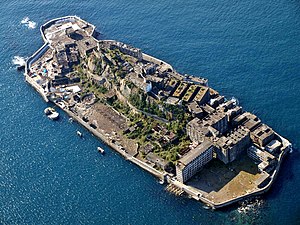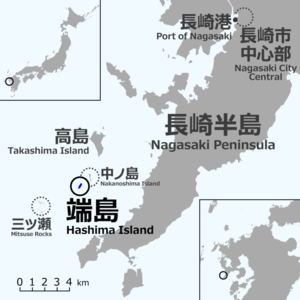Hashima (island)
| Hashima | |
|---|---|
| Hashima, 2008 | |
| Waters | East China Sea |
| Geographical location | 32 ° 37 '40 " N , 129 ° 44' 18" E |
| length | 480 m |
| width | 160 m |
| surface | 6.3 ha |
| Residents | uninhabited |


Hashima ( Japanese. 端 島 , dt. "Border Island ") is a Japanese island located 3 km southwest of Takashima , which belongs to the city of Nagasaki . The island's far more common nickname is Gunkanjima ( 軍艦 島 , dt. "Warship Island"), which, however, also refers to Mitsukejima in Ishikawa Prefecture , and earlier Sarushima in Tokyo Bay .
history
From 1887 to 1974 submarine coal mining was operated from the island ; it has been uninhabited since then.
The island originally had a width of 120 m and a length of 320 m. Through six different embankments with overburden beginning in 1897, it reached its current dimensions of 160 m wide, 480 m long and 1.2 km long. The area is 6.3 hectares.
The heyday of mining on the island began around 1916 under the management of the Mitsubishi group, at that time one of the large zaibatsu (economic conglomerates ). At that time, Japan's first multi-storey reinforced concrete residential building was also built here. At times, up to 5259 workers and family members lived on Hashima.
During the Second World War , the workforce was exchanged for Chinese and Korean forced laborers. The inhumane working and living conditions are estimated to have resulted in 1,300 deaths. During the war, the island was shot at by a US submarine with a torpedo . The attack was aimed at a coal freighter that was anchored off the island.
1959 was one of the highest ever recorded population densities in the world with 83,476 inhabitants per km². Each worker had living space of around 9.9 square meters, and rooms twice as large for married people with families. Toilets, bathrooms and kitchens were shared. The infrastructure was continuously expanded, and due to the limited space, it was often underground. In addition to the residential and administrative buildings, there were also temples and shrines, a police station, a post office, bathing establishments, a sewage treatment plant, a kindergarten, elementary and secondary schools, a gym, a cinema, restaurants, a bowling alley, 25 shops, and a hotel Hospital, swimming pool and brothel; only a funeral service was missing. Electricity and water came from the main island via submarine lines, vegetables, tea and herbs were grown on roof gardens by the residents.
In the course of the energy reforms, it was decided to shut down the plants on January 15, 1974. With the exception of a dismantling squad, all residents were unemployed on the spot and were accordingly in a great hurry to leave the island; the last boat left the island on April 20, 1974. Not only the buildings and machines, but many personal items such as furniture, toys or entertainment electronics, the value of which did not justify the laborious removal, were left on the spot.
Current situation
Today the residential and factory buildings are exposed to weathering and decay. They leave the viewer with the impression of a hectically evacuated restricted area such as around Chernobyl and Prypiat , a former theater of war or other disaster scenarios. For many Japanese, it is a memorial to the ruthless industrialization and exploitation of people and nature - also with regard to its inglorious function as a temporary labor camp.
For a long time it was not allowed to enter the island because of the dangers involved. Graffiti , fire pits, rubbish and other human remains, however, show that the island , which is popularly known as the ghost island, attracted young people in particular.
The city of Nagasaki has now discovered the island's tourist potential and offers regular tours by boat. A secured viewing path has been installed. Hashima has been accessible to visitors again for the first time in 35 years since April 2009.
2001 handed Mitsubishi Materials , the island of the city Takashima (incorporated to Nagasaki in 2003), after which the mayor a petition for registration as a UNESCO - World Heritage started. A committee was founded, which in 2003 was registered as an NPO under the name Gunkan-jima o Sekai Isan ni suru ( 軍艦 島 を 世界 遺産 に す る , "Let's make Gunkan-jima a world heritage site") . In November 2006, the Hashima coal mines were placed on the World Heritage candidate list Kyūshū / Yamaguchi no Kindaika Sangyō Isangun ( 九州 ・ 山口 の 近代 化 産業 遺産 群 , dt. "Industrial Heritage of Modernization in Kyūshū / Yamaguchi"), based on a proposal by the governors of Kyushu goes back. In September 2008, the national authority for cultural affairs submitted five of this list, including Hashima, to UNESCO as a proposal by Japan and declared a UNESCO World Heritage Site in 2015.
Origin of name
- Hashima (border island): Seen from the main island, it is the last visible island belonging to Japan in this direction.
- Gunkanjima (Warship Island): The island is completely surrounded by a massive 8-10 m high protective wall against high seas directly on the waterline. Together with their superstructures and winding towers - most of which have since been dismantled or collapsed - and not least because of their comparable size, their silhouette in the twilight is reminiscent of that of a warship. Shortly after the protective wall was completed (1921), a reporter for the Nagasaki Daily News named the island because it now reminded of the Tosa-class warships , the pride of the Japanese navy at the time.
reception

The film Midori naki Shima ( The Greenless Island , 1949) was shot here. Some scenes from the film Battle Royale (2000) were also shot here. Hashima served as inspiration in James Bond 007 - Skyfall in 2011 , but not as a filming location for the fictional deserted island on which the villain Raoul Silva, played by Javier Bardem , has set up his headquarters. In contrast to reality, however, the inhabitants in the film left the island because of a faked contamination. In the docufiction series Future Without People , the island has already been used repeatedly as a reference.
The island also provides the backdrop for the final level of the video game killer7 .
In the manga series Get Backers , Hashima acts as the yakuza's secret base of operations .
Since the end of June 2013, part of the island can be viewed using Google Street View .
literature
- Chronology ( Memento of May 17, 2009 in the Internet Archive ), Making Places, (English)
- Roger Walch: The hidden fortress. Roger Walch visits the ghost island of Gunkanjima ( Memento of September 28, 2007 in the Internet Archive ) (PDF; 83 kB), rowmuse, (English), archived on September 28, 2007 from archive.org
- Yves Marchand and Romain Meffre: Gunkanjima, Steidl-Verlag Göttingen 2013, ISBN 978-3-86930-546-2 (in English)
Individual evidence
- ↑ 後 藤 惠 之 輔 ・ 坂 本 道 徳 : 軍艦 島 の 遺産: 風化 す る 近代 日本 の 象 徴 . 長崎 新聞 社 , 2005, ISBN 978-4-931493-53-7 , p. 38 .
- ↑ な が さ き 暮 ら し 情報 (エ リ ア 別 生活 情報 : 高 島 地区) . In: な が さ き 暮 ら し ホ ー ム ペ ー ジ . Nagasaki City, accessed July 31, 2016 (Japanese).
- ↑ a b c Christoph Gunkel: Ghost town in the ocean. In: one day . November 27, 2009, accessed July 13, 2010 .
- ↑ The island of Hashima> Japaninfo
- ↑ 軍艦 島 、 一般 公 開始 ま る 夫 の 遺 影 と と も に 「里 帰 り」 も . In: Asahi Shimbun . April 22, 2009, archived from the original on April 25, 2009 ; Retrieved June 29, 2013 (Japanese).
- ↑ 「軍艦 島 を 世界 遺産 に す る 会」 活動 略 歴 . (No longer available online.) NPO 法人 軍艦 島 を 世界 遺産 に す る 会 , archived from the original on May 18, 2009 ; Retrieved May 10, 2009 (Japanese). Info: The archive link was inserted automatically and has not yet been checked. Please check the original and archive link according to the instructions and then remove this notice.
- ↑ 九州 ・ 山口 の 近代 化 産業 遺産 群 が 世界 遺産 暫定 リ ス ト 入 り 軍艦 島 な ど 本 県 4 カ 所 . Nagasaki Shimbun, September 27, 2009, archived from the original September 6, 2012 ; Retrieved May 10, 2009 (Japanese). The UNESCO entry can be found under The Modern Industrial Heritage Sites in Kyûshû and Yamaguchi
- ↑ UNESCO World Heritage Center: Sites of Japan's Meiji Industrial Revolution: Iron and Steel, Shipbuilding and Coal Mining. Retrieved September 6, 2017 .
- ↑ Frank Lovece: 'Skyfall' James Bond still stirs series principals. In: Newsday. November 8, 2012, accessed July 29, 2013 .
- ↑ The island on Google StreetView
Web links
- Video: new hashima youtube part1
- “Ghost town in the ocean” for one day
- Saiga Yuji: Photos - shortly before the island was abandoned and decades after, (Japanese)
- Picture gallery (English, Japanese)
- Visit to the island by photographer Fritz Schumann (German)
- Photos - now and then (English) ( Memento from January 13, 2015 in the Internet Archive )
- Find Hashima




